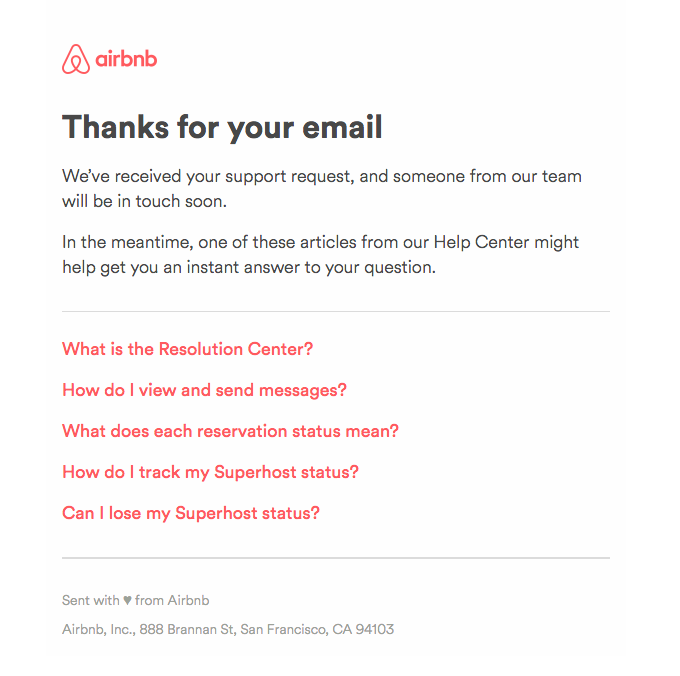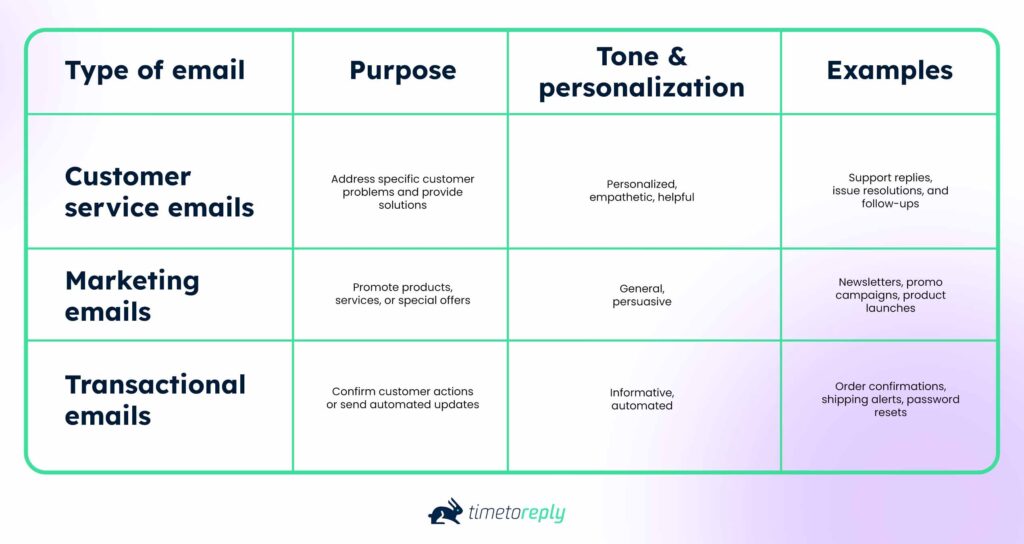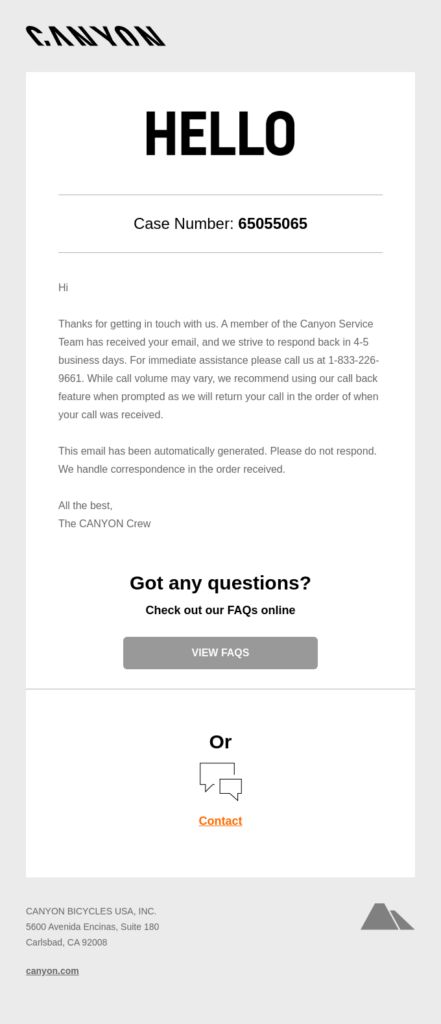Customer service emails provide an excellent opportunity to engage directly with your customers. These emails are more than just replies—they’re a direct channel to create positive experiences, build trust, and strengthen relationships with your customers.
How well you manage and execute customer service emails can affect how customers view your brand and overall impact sales and ROI.
When handled poorly, they can leave your customers feeling ignored, frustrated, or dissatisfied. But done right, they resolve issues quickly and even turn unhappy customers into ambassadors.
In this post, we’ll show you how to manage customer service emails that provide clear solutions, use the right tone, and build a lasting positive relationship.
Keep reading to learn more.
Customer service emails are direct, professional communications between a company and its customers. They’re a vital part of a company’s customer service strategy, as they often serve as the primary mode of communication for support teams.
Customer service emails are mainly designed for customers to:
Additionally, these emails allow support teams to respond thoughtfully by providing step-by-step guidance, technical solutions, or follow-up instructions. This type of communication ensures that your customers feel heard, understood, and valued.
When customers face challenges, they often reach out via email to express concerns, ask questions, or request assistance. With customer service emails, companies can provide clear, detailed solutions in writing, which customers can refer to later.
The image below is an example of a customer service email from Airbnb:

Image via Airbnb
Fortunately, for customers, social media is also available if email communication attempts fail. However, it is not a good day for your brand or business if users are taking to social media to air their complaints and frustrations.
Avoid negative brand attention by prioritizing customer service emails, ensuring your customers enjoy their email interactions with your staff. Instead of social media complaints, you may receive positive reviews that ultimately benefit your brand reputation.
Also Read:
Customer service emails are important because they reflect your brand’s voice, values, and responsiveness. They serve as an extension of your business, providing direct communication with your valued customers.
Email communication remains the go-to channel for customer support. In fact, according to a report, 79% of global consumers receive email communication, and about 53% consider it the most effective channel for customer service.
For this reason, how you respond shapes your customer’s entire perception of your brand. Your message shows customers how much you value their time, concerns, and loyalty.
Every email you send is a reflection of your company’s values, professionalism, and commitment to customer care. A well-crafted message shows customers that you respect their time, take their concerns seriously, and appreciate their loyalty.
Thoughtful, timely replies can reinforce trust, boost customer satisfaction, and even transform negative experiences into positive ones. It can also turn frustrated customers into long-term brand advocates.
Conversely, slow or impersonal responses can leave customers feeling ignored or undervalued, damaging your brand’s reputation and potentially driving them away permanently. The quality of your customer service emails can be the deciding factor between a lost customer and a loyal one.
Customers expect quick and effective responses to customer service emails in our ‘always-on’ economy.
The average response time to answer a customer service email is 12 hours. By this time, many customers have become frustrated and will consider switching to a more responsive competitor.
In short, every customer service email is an opportunity to deliver value, solve problems, and strengthen customer relationships. Here are a few more reasons why customer service emails are essential:
Also Read:
It’s important not to confuse customer service emails with marketing and transactional emails. While marketing and transactional emails are also vital for your business and communication strategy, they serve entirely different purposes from customer service emails. Here’s how:
These emails focus on promoting products, services, or special offers. Marketing emails are mainly designed to drive sales and engagement, not address customer issues.
These transactional emails are automated notifications triggered by specific customer actions, like order confirmations, shipping updates, or account changes. They are informational and not personalized to address customer service needs.
In contrast, customer service emails are more personalized and problem-solving. They aim to directly address customer issues and offer resolutions.
The table below compares the purpose, tone, personalization, and examples of these email types:

Customer service agents deal with countless queries, complaints, and responses daily. Knowing how to effectively respond to each customer service email type means your team is prepared to send quick, friendly, and effective customer service emails in return.
Customer service emails come in different forms and types, each with its unique purpose. Understanding the different types of customer service emails and how to write them can help your team deliver timely, helpful, and on-brand responses at every stage of your customer journey.
Here are the common types of customer service emails you should know:
Acknowledging your customer’s query, complaint, or simple inquiry makes them feel heard. It reassures them that their concern has been received and that your team will address their queries within a reasonable timeframe.
Customers receive these first emails after submitting a query, issue, or request. The purpose of these customer service emails is to confirm receipt of a customer’s message and set expectations on response time.
Here’s what to include in these customer service emails:
This email example from Canyon shows how to properly acknowledge a customer’s email:

Image via Canyon
Also Read:
Resolution emails are sent after an issue has been investigated and resolved. They aim to explain the solution clearly, offer next steps (if needed), and ensure the customer is satisfied.
Providing a clear and quick resolution improves customer experience. These customer service emails communicate how a problem has been resolved and close the support loop.
Here’s what to include in your resolution email:
The customer service email below is an example of a resolution email from Squarespace:

Image via Squarespace
You can use follow-up customer service emails to check in after an interaction, especially if the issue wasn’t fully resolved or needs monitoring.
These customer service emails aim to show ongoing care, gather feedback, or confirm that the resolution worked.
Include this in your follow-up emails:
Here’s a customer service email example of a follow-up email from Huckberry notifying a customer about a successful return:

Image via Huckberry
Also Read:
Even with careful planning and the best intentions, things can still go wrong—that’s when apology emails become an essential part of your customer service email toolkit.
A sincere apology can go a long way in retaining a customer. Send an apology email when there’s a delay, mistake, outage, or miscommunication—especially if the issue originated from your end.
Even when the error isn’t directly your fault, it’s often still necessary to apologize for any inconvenience caused to your customer.
The main purpose of these customer service emails is to acknowledge a mistake, take responsibility, and offer reassurance or a solution. Retaining a customer is always better than losing one.
Here’s what to include when writing this customer service email:
This email example shows how G2 took responsibility for an error, gave an explanation, and apologized for any inconvenience. By sending this customer service email, the brand was able to reassure the customer of improved future service:

Image via G2
Requesting feedback is an effective way to improve your customer service email strategy. These emails are sent after resolving a query to ask how your customer felt about the service or support they received.
The purpose of these customer service emails is to gather insights on service quality and identify areas for improvement.
Here’s what to include in your feedback request email:
In the customer service email example below, Virgin Atlantic requests feedback on how likely it is for the customer to recommend the airline after their flight:

Image via Virgin Atlantic
These customer service emails provide customers with guidance, instructions, or updates not tied to a specific issue. Examples are onboarding help, feature updates, or FAQs.
The purpose of informational emails is to proactively support customers by answering questions before they even ask.
Include the following in this type of customer service email:
The customer service email below shows how Google Bard (now known as Gemini) provides helpful updates and resources:

Image via Bard
When frontline support can’t resolve an issue, you escalate it to the appropriate team or specialist. You can use these customer service emails for internal or external communication.
You send an escalation email when your customer support team needs to transfer the customer to a specialist, manager, or another department for advanced support.
Sending an escalation email ensures that complex or unresolved issues receive the proper attention.
Include the following when sending an escalation email:
Example: “We’ve escalated your request to our technical support team. The team will review your case and reach out within the next 12 hours.”
Writing customer service emails from scratch each time can slow down your team and create inconsistent messaging. That’s why having well-crafted customer service email templates is essential.
These customer service email templates help your support team respond faster, stay on-brand, and provide clear, helpful responses every time. These templates shouldn’t feel robotic but strike a balance between structure and personalization.
Here’s what to include in your customer service email templates:
Also Read:
Having a template for each type of customer service email helps your team reduce its response time. It helps them respond quickly and consistently while maintaining a professional tone.
Below are sample templates for each of the seven main types of customer service emails:
Subject: We’ve received your request
Hi [Customer Name],
Thanks for reaching out. This is to let you know that we’ve received your message and opened a support ticket to look into it.
Your ticket number is: [#123456].
Our team is already reviewing the details and will get back to you within [expected time frame] with an update or resolution.
Thanks for your patience!
Best,
[Your Name]
[Company Name]
Subject: Check-in on your recent support request
Hi [Customer Name],
We want to follow up regarding your recent query about [issue/topic]. Has the issue been resolved, or is there anything else we can help with?
Your satisfaction is important to us, and we’re here to assist in any way we can.
Looking forward to your reply.
Warm regards,
[Your Name]
[Company Name]
Subject: Your issue has been resolved
Hi [Customer Name],
Great news—we’ve resolved the issue regarding [brief description of issue].
Please check and confirm everything is now working as expected. If you need further assistance or have concerns, don’t hesitate to reply to this email.
Thanks for your patience and for giving us the chance to make things right.
Best,
[Your Name]
[Company Name]
Subject: We’re sorry about the inconvenience
Hi [Customer Name],
We sincerely apologize for the inconvenience caused by [briefly describe the issue]. For example, delayed delivery, system outage, etc.
We completely understand how this may have affected your experience, and we truly regret any disruption it caused. Please rest assured that our team has addressed the issue and is taking careful steps to ensure it doesn’t happen again.
Thanks for your understanding and continued support.
Warm regards,
[Your Name]
[Company Name]
Subject: Your request has been escalated
Hi [Customer Name],
Thanks for your patience. We’ve escalated your issue to our [specialized team/manager], who will be better equipped to assist with this.
You should hear from them within [timeframe]. In the meantime, feel free to reach out if you have additional questions.
Best regards,
[Your Name]
[Company Name]
Subject: How did we do?
Hi [Customer Name],
We’d love to hear your thoughts on your recent experience with our support team.
Would you mind taking a minute to fill out a short feedback form? Your insights help us improve and serve you better:
[Insert link to survey]
Thanks again for choosing us!
Cheers,
[Your Name]
[Company Name]
Subject: Here’s an update on your request
Hi [Customer Name],
We want to share a quick update on your recent support case regarding [brief description].
[Provide update.] For example, “Our technical team is actively working on the issue and expects a resolution within 24 hours.”
Thanks for your patience, and we’ll keep you informed of any further progress.
Best,
[Your Name]
[Company Name]
Also Read:
To get the most out of your brand’s customer service emails, you need to write them with the following best practices:
Sending customer service emails is just one part of the job. Tracking the performance of your customer service email system is equally important for improving response times, customer satisfaction, and overall service quality.
You need to track the right performance metrics to know if your customer service emails are helping your customers. These numbers show you what’s working, where your team is falling short, and how you can improve customer support experiences over time.
Here are the most important metrics to track for customer service email performance:
Response time is one of the most important metrics in any customer service email system. It measures how quickly your team replies to a customer’s initial message. It also sets the tone for the entire support experience.
Fast replies show that you value your customers’ time. If a customer has to wait hours or days for a reply, they may lose trust in your business.
You can improve your response time by:
Resolution time measures how long it takes to fully solve a customer’s issue, from initial contact to the final confirmation that the problem is solved.
This metric indicates how efficient your support team is at resolving issues and can strongly indicate customer satisfaction with your service.
If resolution times are high, it could mean that:
Try to send clear, detailed replies to reduce the number of back-and-forth messages. The faster a problem is solved, the better the experience for the customer.
This metric shows the percentage of customer issues successfully resolved through customer service emails.
A high resolution rate indicates that your team is effectively addressing problems via email. However, if customers frequently escalate to phone or live chat, it may signal that your email responses aren’t meeting their needs.
To improve the resolution rate:
Also Read:
After resolving a customer’s issues, follow up with a satisfaction survey to gauge their happiness with the support they received. Sending these customer service emails helps you measure the effectiveness of your team’s response and identify areas for improvement in your interactions.
After their issue is resolved, send a short survey in these customer service emails with a question that says,
“How satisfied were you with the support you received?”
Customers rate the service on a scale (for example, 1 to 5). The higher the score, the better.
To keep CSAT scores high:
This measures how likely a customer is to recommend your brand to others based on their overall experience. This is not done after just one support interaction. Tracking NPS helps you understand how your support emails affect customer loyalty.
You can ask a question like:
“How likely are you to recommend us to a friend or colleague?”
Customers respond on a scale from 0 to 10:
If customers aren’t opening your support emails, even the best response won’t make a difference for your customer service emails.
Low open rates might mean:
Use clear subject lines to improve your open rates and include your brand name in the sender name.
Email backlog is the number of unanswered emails in your queue. This metric is also important to effectively manage customer service email queues and provide fast support. A growing backlog means your team may be overwhelmed.
To manage it:
Also Read:
Improving customer service emails goes beyond just following best practices. It’s about actively seeking opportunities to elevate your email strategy and create better customer experiences.
Here’s how you can improve the quality of your customer service emails:
The key to improving is getting your customers’ feedback. Regularly review the feedback you receive about your customer service emails, whether through surveys, customer satisfaction scores (CSAT), or direct replies.
When analyzing customer feedback, look for patterns, such as recurring issues or customer complaints, and use that data to improve your email responses.
A/B testing is a method of testing different versions of the same email to see which performs better.
Try varying subject lines, calls to action, or tones and see which one gets better response time, customer satisfaction, and follow-up actions. Then, use the findings to improve your customer service emails continuously.
A well-organized knowledge base can support your customer service department and help them answer customer inquiries more efficiently.
This includes guides, FAQs, or troubleshooting steps regularly referenced in customer service emails. Update your knowledge base and integrate it into the tools your team uses.
As much as clear communication is important, an empathetic tone can make a big difference when sending customer service emails.
Regularly train your team on using positive, empathetic language, even when responding to challenging or negative customer experiences. Show customers you understand their frustrations and are committed to resolving their issues.
Use customer service analytics and KPIs (Key Performance Indicators) like response time, resolution time, and customer satisfaction ratings to measure the effectiveness of your emails.
Regularly review these metrics to identify areas of weakness and refine your email strategy accordingly.
Also Read:
Good customer service emails answer all the customer’s questions rapidly and efficiently. It is recommended that you set up customer service email templates that your team has easy access to.
This ensures all communication across individual customer service agents is consistent while reducing time to reply.
Do you want to read some customer service email templates? Head over to our customer service emails response templates blog to read more.
Also Read:
Even experienced customer service teams can sometimes slip up when crafting emails. These mistakes can harm your brand’s reputation, upset customers, and negatively affect customer relationships.
Here are some common errors to watch out for:
Also Read:
You need the right software and tools to improve your customer service email processes. These tools can help you manage emails, track responses, automate workflows, and ensure your team delivers quick, consistent, personalized service.
Here are some of the best tools for customer service email management:
The right tools can make all the difference in delivering fast, reliable, and personal customer service emails. These tools help you streamline workflows, track performance, and ensure no customer message slips through the cracks.
Here are some of the best tools for managing customer service emails:

Image via Timetoreply
This email response time tracker helps support teams monitor how quickly they reply to customer service emails. It gives real-time insights, sets reply time benchmarks, and helps improve SLA compliance.
With timetoreply, your team can promptly address every customer service email. It ensures your support team does not overlook any queries, and they follow up on all requests quickly.
With timetoreply, you can measure average reply times, response rates, and resolution timelines across individual agents and teams. The tool gives you full visibility into your customer service email performance.
Additionally, it works with your existing email platform (like Gmail or Outlook) and gives you insights that help improve customer satisfaction and service quality.

Image via Zendesk
A full-service customer support platform that includes email ticketing, live chat, and a knowledge base. Zendesk lets you organize customer service emails, automate responses, and prioritize tickets by urgency.

Image via Freshdesk
Freshdesk offers a user-friendly help desk with email ticketing features. It allows support agents to categorize, assign, and resolve customer service emails quickly using pre-set rules and canned responses.

Image via Front
Front is a collaborative email platform where teams can manage shared inboxes and reply to customer service emails in real-time. It also integrates with CRMs and help desk tools to view each customer conversation fully.

Image via Intercom
Intercom is a comprehensive customer service and engagement platform that combines customer service emails, live chat, and proactive messaging. It offers automation, advanced customer segmentation, and analytics to track response times and customer satisfaction.
Also Read:
In customer service, response time is one of the most significant factors influencing customer satisfaction. When customers reach out for assistance, they expect you to respond promptly.
A slow response can irritate customers and also tarnish your brand’s reputation. On the other hand, prompt and thoughtful replies can create positive experiences and reinforce customer loyalty to your brand.
When response times lag, an angry customer may feel neglected, leading to dissatisfaction and potentially losing business.
It’s important to set clear expectations for how quickly customers will hear back from you and then work toward meeting those expectations consistently.
The faster you can respond to inquiries, the better your customers feel valued and supported. This is because your brand’s response time to requests, suggestions, or complaints is the most significant attribute leading to customer satisfaction.
Also Read:
With this in mind, here’s how you can improve your response time:
Depending on the nature of the inquiry, you can set internal benchmarks for how quickly your team addresses different customer service emails.
For example, urgent support queries may need to be responded to within 1 hour, while less critical requests can have a longer window. Establishing these goals ensures that your team knows exactly what is expected and helps maintain consistency.
Automation tools can help speed up your customer service email responses. However, automated systems can’t handle all emails. You can automate certain actions, such as acknowledging receipt of the email or providing an estimated timeline for resolution.
Tools like timetoreply let you set up automated replies that reassure customers their inquiry has been received and is being handled. These messages can also set clear expectations by letting them know when to expect a response.
Not all emails require immediate action, so it’s crucial to prioritize those that do to ensure urgent issues are addressed promptly.
Using CRM or email management software, you can categorize incoming emails based on urgency and assign them to the appropriate team members.
This ensures that customers with urgent issues aren’t left waiting for assistance while others are being addressed. Implementing a triage system, where emails are flagged based on their importance, can help improve your response time.
Consistently tracking how long it takes to respond to emails can help you identify areas where your team can improve response times.
Customer service platforms like timetoreply often offer built-in analytics to track how quickly responses are sent and identify trends or patterns that can inform better strategies.
Alongside fast response times, setting expectations with your customers is equally important.
Include expected response time information in your auto-replies or company website so customers know when to expect a reply. This can help reduce frustrations and set a clear, manageable timeline for both sides.
Also Read:
Similar to compliance and security, friendly and quick customer replies matter in customer service emails. This is because sometimes you get access to personal information through these emails. Therefore, your support team needs to be security-conscious.
If your team mishandles customer data or fails to meet legal standards, you could risk more than unhappy customers. Your brand could face penalties, data breaches, and serious reputation damage.
Here are 5 key areas to focus on for ensuring compliance and security in your customer service emails:
Customer service emails often contain personally identifiable information such as names, contact details, order history, and payment concerns. If that data is intercepted or mishandled, it could result in major privacy violations or cyberattacks.
Here’s what to do:
Whether you’re responding to customers in New York or Norway, you must comply with international data protection laws like GDPR, CAN-SPAM, and CCPA.
These laws govern how you collect, store, and use customer information, and the penalties for non-compliance can be steep.
Here’s how to follow global data privacy regulations:
Giving too many people access to your inbox can pose a security risk. Limit access to only the necessary team members, especially when handling customer service emails that contain sensitive data. Without proper controls, you risk internal breaches or accidental exposure of private information.
Here’s what to do:
Email encryption protects messages from being intercepted in transit. Archiving gives you a reliable trail in case of disputes, legal issues, or audits. Without both, you’re working without a safety net.
To encrypt and archive communications, do this:
Even with secure tools, your team is your first line of defense. Mistakes are inevitable if they don’t know the rules or how to handle sensitive emails. Make compliance part of your customer support training and not just an afterthought.
Here’s what to do:
Also Read:
Customer service emails can prove challenging to manage, especially if you do not have visibility over response times and customer satisfaction scores. If your team is not effectively dealing with customer service emails, it can negatively impact customer satisfaction levels, increase customer churn, and ultimately diminish potential revenue.
Using a customer service email software tool, such as timetoreply, can support your customer service team by offering several benefits that include:
Timetoreply produces data that helps you identify areas of improvement. With timetoreply’s insights, managers more effectively manage resources and determine where more training and support are required.
Our easy-to-understand dashboard provides a quick overview of peak email traffic times, individual workloads, average email response times, and average first reply times.
Keeping track of large volumes of incoming mail can prove problematic. Despite your team’s best efforts, there’s always a chance that an important email is missed or forgotten about.
Timetoreply keeps track of emails and sends live alerts to remind customer service agents when an email is about to reach its SLA threshold. This way, your customer service team will never miss a customer service email again.
Using timetoreply equips you with accurate data on the email performance of your customer service teams. Know which customer service agents are struggling to meet their SLAs, how fast their reply time is, and what improvements have been made.
When applied smartly, these data insights can help you achieve higher levels of customer satisfaction and deliver better bottom-line results.
Timetoreply tracks how fast your agents respond to emails, giving you real-time insights into first reply time and average response speed. This helps you reduce wait times, improve customer trust, and optimize your support workflow.
To ensure consistent service across all inquiries, set internal benchmarks for email response times based on the urgency or type of request.
With timetoreply, you gain access to performance reports that clearly outline each agent’s metrics and expectations. This transparency can encourage personal responsibility and continuous improvement without micromanaging.
From trends over time to detailed reports per agent or department, timetoreply offers in-depth analytics to help you fine-tune your service strategy, which makes it easy to scale your service operations intelligently.
With timetoreply, you can track email opens, responses, and follow-ups. This customer experience tracking enables you to see what’s working and what needs improvement.
Platforms like timetoreply integrate with various platforms, including Gmail and Outlook. It also works seamlessly with other customer service tools and sales platforms to help centralize your operations, reduce software switching, and improve internal collaboration.
Also Read:
1. What makes a customer service email effective?
An effective customer service email is timely, empathetic, and tailored to the customer’s specific situation. It addresses the issue, offers a practical solution, and maintains a friendly tone reflecting your brand’s voice.
2. How fast should I respond to customer service emails?
Customers expect a reply within a few hours, and some even expect it within minutes. A fast response shows professionalism and builds trust. Ideally, you should respond within 6-12 hours.
3. What should I do if I don’t have a solution right away?
Let the customer know you’ve received their message and are working on it. Also, set clear expectations for when they’ll hear back. This will help your brand manage frustration and show that you’re actively addressing and not ignoring their issue.
4. What’s the best way to follow up with a customer who hasn’t replied?
Sometimes, customers get occupied with everyday life and forget to check their mailboxes. A polite follow-up after 2–3 business days can be a helpful nudge. Send a polite customer service email, restating the original message, then ask if they still need help, and let them know you’re happy to assist further. This shows proactiveness without being pushy.
5. What’s the most common mistake to avoid in customer service emails?
One of the biggest missteps is using generic, robotic responses that make customers feel like just another ticket. Instead, personalize your replies—even simple touches like using their name or referencing specific details about their issue can make them feel heard and valued.
You will positively impact revenue by impressing customers with fast, friendly, and effective customer service email responses. Companies that offer a superior customer experience will bring in almost six times more revenue than competitors that offer a sub-standard customer experience.
Timetoreply is the ideal solution for companies that want to gain actionable intelligence into their customer service teams’ email productivity. Our solution is a powerful addition to existing email activities. It does not require any process changes or costly deployments.
Within minutes of activating timetoreply in your Gmail or Outlook email environment, managers gain a granular view of average reply times and conversations. They can also track inbound mails, how quickly requests are resolved, and more.
Without migrating team email activities to a new platform or conducting training to get customer-facing teams up to speed, timetoreply easily slots into existing processes and immediately generates value.
Don’t just take our word for it – schedule a demo now and discover the future of elevated communication strategies.
Get live inbox alerts and reply quickly to customer emails with timetoreply